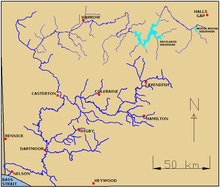The Glenelg River, a perennial river of the Glenelg Hopkins catchment, is located in the Australian states of Victoria and South Australia.
The river rises in the Grampian Ranges and flows generally north, then west, then south, for over 350 kilometres (220 mi),[10] making the river the longest river in south-west Victoria and third longest overall. A short stretch of the lower end winds through southeastern South Australia before returning to Victoria to enter Discovery Bay at Nelson. The Glenelg River is a central feature of the Lower Glenelg National Park.
The river was named after Colonial Secretary Baron Glenelg, Charles Grant, by Major Thomas Mitchell in August 1836.[1][12]
Large amounts of water diverted from the upper reaches of the river for agricultural purposes, including irrigation and town water demands. The estuary is listed under the Heritage Rivers Act, 1992 (VIC) and is a nationally important wetland.
- ^ a b Mitchell, Thomas (1838), Three Expeditions into the interior of Eastern Australia (e-book), vol. 2, London: Boone
- ^ "Lower Glenelg National Park, Discovery Bay Coastal Park: Visitor Guide" (PDF). Parks Victoria (PDF). Government of Victoria. June 2014. Archived from the original (PDF) on 21 February 2014. Retrieved 20 August 2014.|paren1=omit
- ^ "Glenelg River: 3050: Traditional Name: Worrewurnin". Vicnames. Victoria State Government. 12 August 2011. Archived from the original on 14 January 2014. Retrieved 13 January 2014.
- ^ "Glenelg River: 3050: Traditional Name: Bugara". Vicnames. Victoria State Government. 12 August 2011. Archived from the original on 14 January 2014. Retrieved 13 January 2014.
- ^ "Glenelg River: 3050: Traditional Name: Temiangandgeen". Vicnames. Victoria State Government. 12 August 2011. Archived from the original on 14 January 2014. Retrieved 13 January 2014.
- ^ "Glenelg River: 3050: Traditional Name: Wurri-wurri". Vicnames. Victoria State Government. 10 May 2011. Archived from the original on 14 January 2014. Retrieved 13 January 2014.
- ^ "Glenelg River: 3050: Traditional Name: Barrawy". Vicnames. Victoria State Government. 12 August 2011. Archived from the original on 14 January 2014. Retrieved 13 January 2014.
- ^ "Glenelg River: 3050: Traditional Name: Barker". Vicnames. Victoria State Government. 4 May 2011. Archived from the original on 14 January 2014. Retrieved 13 January 2014.
- ^ "Glenelg River: 3050: Traditional Name: Wurru-wurru". Vicnames. Victoria State Government. 12 August 2011. Archived from the original on 14 January 2014. Retrieved 13 January 2014.
- ^ a b "Estuary facts and figures: Glenelg". Coast & Marine: Estuaries. Glenelg Hopkins Catchment Management Authority. Retrieved 4 June 2014.
- ^ "Map of Glenelg River". Bonzle Digital Atlas of Australia. Retrieved 4 June 2014.
- ^ Bird, Eric (12 October 2006). "Place Names on the Coast of Victoria" (PDF). The Australian National Placename Survey (ANPS). Archived from the original (PDF) on 18 February 2011. Retrieved 23 July 2008.

